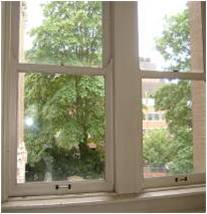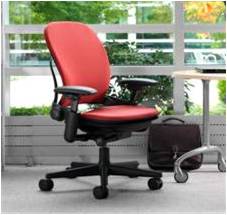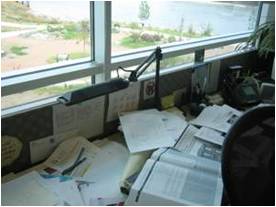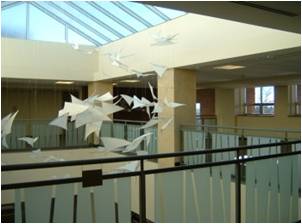Occupant Comfort
Comfortable workers are more likely to be productive and engaged with their work than those who struggle to work in spaces that create barriers and stresses. With an ever increasing number of environmental issues to be mindful of when designing spaces, GSA is developing practices that support both sustainability and worker comfort.
Achieving both Comfort and Sustainability: Key Practices
- Enable occupant control of ambient conditions. One of the best ways to achieve comfort, health, and energy savings is to enable occupants to adjust ambient conditions in their workspace (e.g., the light levels, ventilation, and temperatures).
- Provide adjustable furnishings and technologies. People come in all sizes, heights, and abilities. Thus their workspace furnishings - from the desk chair to the table height - should be easily adjustable to fit all sizes and abilities.
- Educate occupants. When new controls and furnishings are provided, all occupants should be trained in their proper use. Training is often left to the individual occupant who may not even know that the controls exist, let alone use the controls in the proper way.
- Provide quick response to comfort concerns. Research shows that occupants are more satisfied with conditions overall if their concerns are addressed quickly by facilities personnel.
- Provide feedback to occupants on energy use. The energy reduction goals for federal office buildings may sometimes conflict with comfort. Occupants should be informed of how much energy the building is consuming so that they can adjust their behaviors to help achieve energy goals.
Benefits:
Social:
- Improved employee comfort and satisfaction
- Improved employee health
- Improved work performance
Economic:
- Reduced costs of muscular-skeletal injuries
- Reduced costs of illnesses related to interior quality
Environmental:
- Reduced energy consumption
Case Study Results
Six completed federal workplace projects show that comfort can increase dramatically when the design includes improvements in lighting, air quality, ergonomics and thermal conditions.
Although the designs differed in implementation details, each involved improvements in electric lighting, better access to daylight, materials selected to improve air quality, adjustable task light, and ergonomic furnishings.
Results
| Factor | Percentage Improvement |
|---|---|
| Air Quality | 33% |
| Cleanliness | 33% |
| Furniture Adjustability | 33% |
| Furniture Comfort | 30% |
| Daylight | 23% |
| Views | 23% |
| Temperatures | 18% |
| Amount of Light | 17% |
| Visual Comfort | 17% |
| Noise Levels | 3% |
Project Checklist
- Ergonomic chair is provided for all regularly occupied workstations
- Work tables, desks and files can be easily moved by occupants to a preferred arrangement within workstations
- Adjustable, moveable task lamps with compact fluorescent lamps are provided in all workstations
- The computer screen and keyboard are adjustable and can be moved within the workstation
- Individual workstations provide control over ventilation with operable windows, underfloor air distribution vents, or operable ceiling vents
- Windows have adjustable blinds or other sun control devices
- Meeting spaces for 6 or more people have ventilation and temperature controls in the space
- Conference rooms have adjustable lighting so that some lights can remain on while a projector is in use
- Printers and copiers are centralized and separately ventilated to reduce air quality problems.
- Paper management (such as central filing; increased electronic storage) reduces dust and particulates
- Occupant comfort is regularly assessed through surveys or other means and occupants receive feedback from the survey results
- Facility personnel respond promptly to comfort complaints
- Occupants are made aware of the energy and sustainability goals of their facilities
- Occupants receive ongoing feedback about the energy performance of the building through the use of a dashboard or other display methods
Source(s):
- GSA Public Buildings Service, "The New Federal Workplace", June 2009
- U.S. General Services Administration, "The GSA Hallmarks of the Productive Workplace", Rev. 01/06, 1999
Gallery



Related Topics
Adjustable Equipment
To promote occupant comfort, equipment should be adjustable. This includes ergonomic seating and desks, well-designed cleaning equipment, occupant controlled lighting, and controllable daylight/glare control.
Cleanliness
Building cleanliness is both the process of removing dirt and contaminates from the building as well as the process of maintaining this state. Keeping the facility clean decreases the occurrence of “sick building syndrome” and uses less toxic chemicals in the process. Occupants are also more likely to express satisfaction and lose less productivity due to absenteeism in a well-cleaned building.
Daylight Controls
Daylight controls measure the amount of daylight/ambient light in a room and adjust the electric light levels accordingly. Daylight controls should be designed with multiple zones to reflect the differing levels of ambient light entering a space. In areas closest to the window where there is a great deal of daylight in the space, the controls dim the electric light levels; and in areas farther away from the window with lower levels of daylight, the controls increase the amount of electric light in the space.
Energy Efficiency
Energy efficiency is a comparison of the amount of energy used compared to the amount of output produced. In the built environment, this means using the least amount of energy (electricity, natural gas, etc.) to operate a facility appropriately. Steps that can help a building run efficiently include: ensuring there are no air leaks, using sensors or timers to ensure the building isn’t operating when vacant, and using energy-efficient equipment.
Ergonomics
Ergonomic workspaces are designed to facilitate work while minimizing stress and strain on the body. They also accommodate user preferences and comfort. They include height-adjustable desks that can be easily moved around on casters, fully adjustable chairs, monitor arms, keyboard trays, footrests and document holders. It is important to train employees on how to adjust their workspaces to maximize comfort and health.
Guiding Principles for Sustainable Federal Buildings
The Guiding Principles for Sustainable Federal Buildings and Associated Instructions are a set of sustainable principles for integrated design, energy performance, water conservation, indoor environmental quality, materials, and resilience aimed at helping Federal agencies and organizations:
- Reduce the total ownership cost of facilities
- Improve energy efficiency and water conservation
- Provide safe, healthy, and productive built environments
- Promote sustainable environmental stewardship
Guiding Principles for Sustainable Federal Buildings and Associated Instructions
Healthy Buildings
Health, as defined by World Health Organization in its 1948 constitution, is “a state of complete physical, mental, and social well-being and not merely the absence of disease or infirmity”. This definition of health has been expanded in recent years to include (1) resilience and the ability to cope with health problems and (2) the capacity to return to an equilibrium state after health challenges.
These three health domains - physical, psychological, and social - are not mutually exclusive but rather interact to create a sense of health that changes over time and place. The challenge for building design and operations is to identify cost-effective ways to eliminate health risks while also providing positive physical, psychological, and social supports as well as coping resources.
Learn more about Buildings and Health.
Indoor Air Quality (IAQ)
Indoor Air Quality (IAQ) refers to the state of the air within a space. A space with good indoor air quality is one that is low in toxins, contaminants and odors. Good air quality possible when spaces are well ventilated (with outside air) and protected from pollutants brought into the space or by pollutants off-gassed within the space. Strategies used to create good IAQ include bringing in 100% outside air, maintaining appropriate exhaust systems, complying with ASHRAE Standard 62.1, utilizing high efficiency MERV filters in the heating ventilation and air conditioning (HVAC) system, installing walk-off mats at entryways, prohibiting smoking with the space and near operable windows and air intakes, providing indoor plants, and using only low-emitting / non-toxic materials and green housekeeping products.
Noise Pollution
Noise pollution is the presence of unwanted or unpleasant noise. Noise pollution comes from improperly functioning HVAC equipment, street noise, or the conversations of others. Besides the fact that it is obnoxious and distracting, noise pollution can be detrimental to human health. It is therefore important to consider ways to eliminate noise pollution in project planning.
Whole Building Design Guide | Indoor Environmental Quality![]()
Occupant Comfort
Workspaces should be designed and operated to support the functional and environmental needs of occupants. Design for thermal comfort should be based on ASHRAE Standard 55. Design for air quality should be based on ASHRAE 62. Occupant comfort should be assessed frequently once a building is occupied, using ASHRAE’s Performance Measurement Protocols for Commercial Buildings.
ASHRAE.org | Standards 62.1 and 62.2![]()
Occupant Control
Workspaces should be designed to allow for occupant control over lighting (light switches, occupant or daylight sensors with override capability, etc) and thermal comfort (operable windows, individual thermostats, and underfloor air diffusers). Building operators should provide information about control use to occupants.
Occupant Engagement
Occupant engagement involves communicating with, enabling and empowering building occupants to help meet sustainability goals for the building. This can involve providing information on actions occupants can take to improve building performance and resource efficiency, while making it easy and appealing for occupants to do so (e.g. actions that improve productivity).
Occupant Satisfaction
A primary goal of sustainable design is to maximize occupant comforst and satisfaction, while minimizing environmental impact and costs. Comforst and satisfaction are important for many reasons, not least of which is that they correlate positively with personal and team performance. The greater the satisfaction, the higher the productivity and creativity of an organization. It has also been demonstrated that occupant satisfaction impacts staff rentention.
Space Reconfiguration and Renovation
As needs change over time, tenants often need to convert space or phase the conversion of individual space or rooms to meet these changing needs.
Thermal Comfort
Workspaces should be designed to provide the optimum level of thermal comfort for the occupants. Occupant comfort should be based on ASHRAE Standard 55.
ASHRAE.org | Standards 62.1 and 62.2![]()
Views (to the Outside)
Building occupants with access to outside views have an increased sense of well-being. Keeping employees happy and healthy is good for business, as happy employees show higher productivity and increased job satisfaction, resulting in less employee turnover. In order to provide equitable access to views, it is recommended that private offices are located toward the core of the space and that low workstation panels are installed to allow for maximum daylight penetration. Use glass walls and partitions to enable views out from interior spaces.
Worker Productivity
Productivity is the quality and/or quantity of goods or services produced by a worker. Good indoor environmental quality – access to views, comfortable temperatures, comfortable lighting, good acoustics, and ergonomic design, etc. – supports employees’ ability to do a good job. On the other hand, compromised IEQ hinders their ability to work. It makes good business sense, then, to keep employees happy, healthy, and productive. This, in turn, creates more and higher quality output for organizations.

